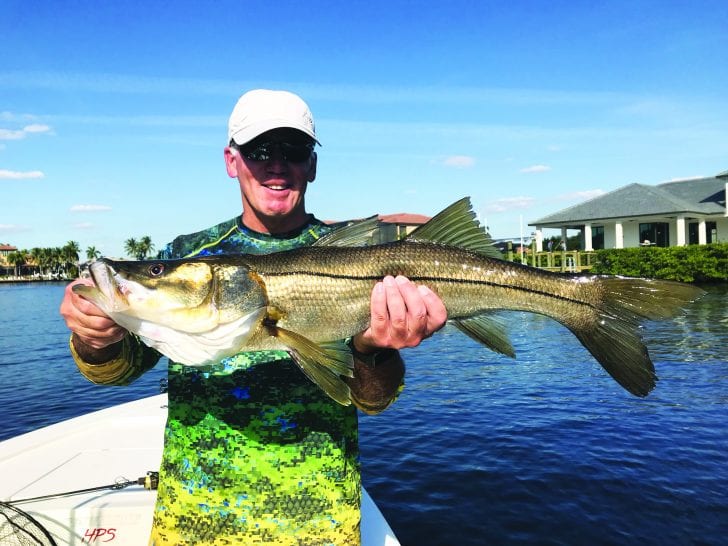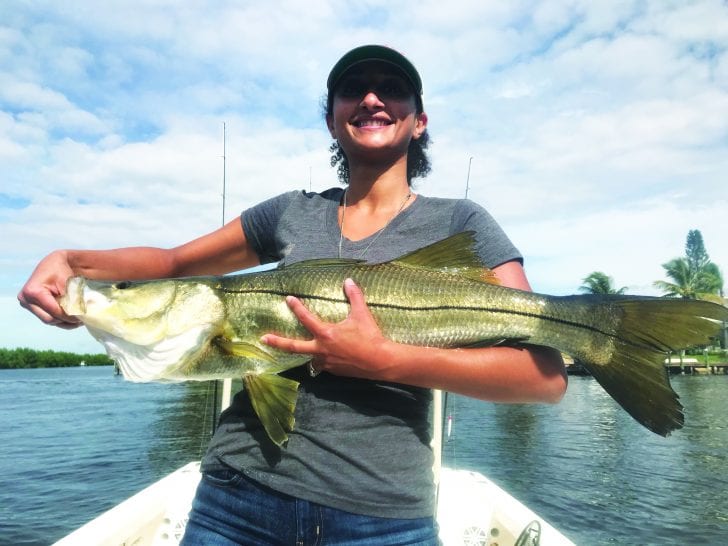by Captain Terry Fisher
Every month of every year will present different challenges to all anglers. This year should be no different from the previous year, in regards to knowing when or where to go in quest of a particular species. Each year at this time, I present my views on what I believe will hold true for the new calendar year as to what species is best to target and during which months (on a ‘quarterly’ basis) as follows:
JANUARY- MARCH
Sheepshead will lead the charge as the bigger fish migrate from the gulf waters and infiltrate docks, seawalls and mangroves. They will be found in each and every ‘PASS’ (Redfish, Captiva and Boca Grande) as well as creek mouths and back waters with structure, especially those areas with old piles and rocks. I fish for them with shrimp tails while periodically hurling the heads for chum. Use small #1 or # 2 size bait hooks.
Snook is a year around favorite of mine and they have moved from the beaches to the canals and creek mouths. Artificial baits such as ‘twitchbait’ (MR 19 MirrOLure); Shallow running swim or ‘crank’ baits; weedless soft plastics or topwater plugs (Heddon Spook Jr.) will all produce. Preferred live baits are sardines, herring, pinfish, mullets and big shrimps.
Jack Crevalle will prevail in canals and creeks. The will be spotted busting glass minnows at the surface. Almost any artificial presentation will work when they are feeding. Use Sardines or shrimp for live bait presentations.
Spanish Mackerel will begin their migration southward. Artificial baits such as gold and silver spoons, Gotcha Lures for good action. Use wire leaders to prevent cutoffs. Watch for diving birds and usually the mackerel will be a part of the action together with Lady Fish.
Grouper/Snapper move closer to inshore as water temperature cools. Causeway, Edison, Helens, Pace and other well know reefs will hold fish. Shrimp, pinfish, sardines and squid are my baits of choice.
APRIL-JUNE
Seatrout will inhabit grass flats in 3’ to 6’ of water. Look for murky green color indicating sea grasses. Larger seatrout will be more prevalent during the early spring month (April). Artificial baits of all types will work. Also, fish shrimp under a cork (weighted or free-lined) suspended above the seabed.
Tarpon will begin their migration from the southern waters of Mexico. Look for them off Ft. Myers Beach and the beaches of the outer islands of Sanibel, Captiva, Cayo Costa. Fish sardines, threadfins, mullets or big pinfish under a cork or balloon for best results. Anchor up ahead of their paths.
Snook will begin to move from the canals and creeks to the beaches and passes.
Redfish become more plentiful and larger inshore with higher tides and stronger currents. Look for them around oyster beds and mangrove islands on incoming tides. Big shrimp, cut Pinfish, mullet and crabs are all great baits to use fished on the seabed or suspended under a popping cork.
Mangrove Snapper are an inshore favorite this time of year. They are very tasty. Live cut shrimp on small circle hook placed under docks and around mangroves should yield plenty, for a nice meal.
Triple Tail/King Mackerel/Cobia/Permit offshore may all join the party as waters warm. Trolling artificial lures for mackerel. Try big shrimp for tripletail and cobia. Mackerel and cobia will likely be caught while fishing for snapper on the reefs mentioned above.
JULY-SEPTEMBER
Redfish become the predominant fish. The bigger ones (around September time frame) are known as ‘Bull Reds’. Warmer water triggers their migratory senses to move closer inshore. High tides, plenty of food and protection give them the ability to eat, spawn and fatten up for their long winter offshore. They will be found in schools. They love artificial gold spoons and soft weedless plastics. Live shrimp, pinfish and crab are great baits to use in back country locations off of oyster shoals and around mangrove islands.
Snook will be found in the same locations as redfish during this time of year. While targeting redfish, one will likely catch snook on the same presentations used for the redfish.
Seatrout will remain active, but will be smaller in size. Look for the larger ones in the potholes in the shallower waters of Pine Island Sound and Tarpon Bay.
Grouper/Snapper will require going further offshore to find. The bigger ones will hold in 45’ to 90’ of water.
Permit are fighting machines and will show up on the reefs. Live crab is my bait of choice when I know Permit is around.
OCTOBER-DECEMBER
Redfishing may be at its finest early on this ‘quarter’. However, depending on the water temperatures, it will likely be the ‘beginning of the end’ for the larger Bull Reds. Usually, the month of October is the best and things will begin winding down sometime in November, when cooler water temperatures move the schooling fish offshore.
Black Drum is a cousin to the redfish and a powerful foe. They are more of a cooler water species and will be caught all winter long in deep holes, under docks and rock structures, including bridge piles. I have good luck using large live shrimps for these guys.
Seatrout are here year around and are usually plentiful to catch and release but not as big during the last ‘quarter’ of the year.
Pompano/Spanish Mackerel will, for the most part, be by-catches while targeting seatrout. These species are migratory and will show up from time to time throughout the year.
This is Captain Terry Fisher of Fish Face Charters LLC of Cape Coral, Florida. Check out my website at www.fishfacecharters.com. Call me direct at 239-357-6829 or email me at fishfacecharters@yahoo.com for any charter request. I am also available on your vessel (by the hour) as ‘Captain for Hire’ to assist with navigation, safety, fishing locations and techniques that I use, to insure your every trip is successful.


